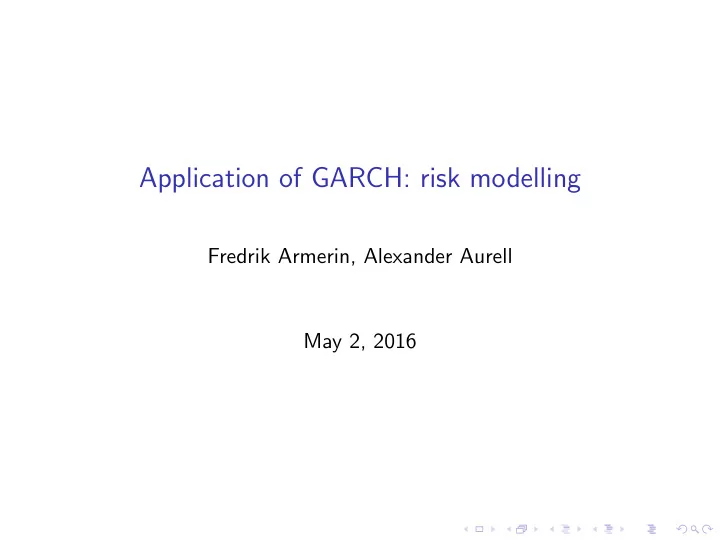

Application of GARCH: risk modelling Fredrik Armerin, Alexander Aurell May 2, 2016
OMXS30 OMXS30 is a weighted mean of the 30 most traded stocks the Stockholm stock exchange.
OMXS30 OMXS30 price from 01-01-2009 until today:
Problem: risk estimation The question we will investigate: What risk are we exposed to if we buy one share of OMXS30 and hold it for 10 days?
Problem: risk estimation The question we will investigate: What risk are we exposed to if we buy one share of OMXS30 and hold it for 10 days? Let S t be the value of the index at day t . A typical thing to look at is the quantiles in the left tail of S 10 − S 0 . This gives an estimate of the worst case return (loss of money) in a certain percentage of all possible scenarios. We will model the returns in two ways; a naive approach based on fitting a normal distribution and with a GARCH process.
Log-returns Transforming past index values ( S t ) 0 t = − N into its log-reurns, X t = ln( S t / S t − 1 ) yields the following time series:
Naive approach Assume that the log-returns are IID N ( µ, σ ). If we estimate ( µ, σ ) from past index data with (ˆ µ, ˆ σ ), we may write � d √ � � σ Z − 1 � e X 1 + ··· + X 10 − 1 e 10ˆ µ + 10ˆ S 10 − S 0 = S 0 ≈ S 0 where Z ∼ N (0 , 1).
Naive approach By sampling from Z we may calculate empirical quantiles of − ( S 10 − S 0 ). Even better, there is analytical formula for the quantile of − ( S 10 − S 0 ) √ � σ Φ − 1 (0 . 05) � F − 1 1 − e 10ˆ µ + 10ˆ S 0 − S 10 (0 . 05) = S 0 and for the density of S 10 − S 0 µ ) 2 � � 1 � − (ln(1 + x / S 0 ) − 10ˆ � � � f S 10 − S 0 ( x ) = √ √ � exp � � σ 2 2 · 10ˆ 2 π S 0 10ˆ σ (1 + x / S 0 ) �
GARCH approach Fit a GARCH process to the log-returns between day − N and 0.
GARCH approach Fit a GARCH process to the log-returns between day − N and 0. Use this GARCH process to simulate ( S 10 − S 0 ): t = α 0 + � p t − i + � q ◮ σ 2 i =1 α i σ 2 j =1 β j X 2 t − j
GARCH approach Fit a GARCH process to the log-returns between day − N and 0. Use this GARCH process to simulate ( S 10 − S 0 ): t = α 0 + � p t − i + � q ◮ σ 2 i =1 α i σ 2 j =1 β j X 2 t − j ◮ X t = σ t Z t , , Z ∼ N (0 , 1)
GARCH approach Fit a GARCH process to the log-returns between day − N and 0. Use this GARCH process to simulate ( S 10 − S 0 ): t = α 0 + � p t − i + � q ◮ σ 2 i =1 α i σ 2 j =1 β j X 2 t − j ◮ X t = σ t Z t , , Z ∼ N (0 , 1) ◮ Y t = µ + X t
GARCH approach Fit a GARCH process to the log-returns between day − N and 0. Use this GARCH process to simulate ( S 10 − S 0 ): t = α 0 + � p t − i + � q ◮ σ 2 i =1 α i σ 2 j =1 β j X 2 t − j ◮ X t = σ t Z t , , Z ∼ N (0 , 1) ◮ Y t = µ + X t ◮ S 10 = S 0 exp ( Y 1 + · · · + Y 10 )
GARCH approach Fit a GARCH process to the log-returns between day − N and 0. Use this GARCH process to simulate ( S 10 − S 0 ): t = α 0 + � p t − i + � q ◮ σ 2 i =1 α i σ 2 j =1 β j X 2 t − j ◮ X t = σ t Z t , , Z ∼ N (0 , 1) ◮ Y t = µ + X t ◮ S 10 = S 0 exp ( Y 1 + · · · + Y 10 ) From simulations, calculate the empirical quantile of − ( S 10 − S 0 ) = S 0 (1 − exp ( Y 1 + · · · + Y 10 ))
Simulations in Quantlab What results should we expect?
Simulations in Quantlab What results should we expect? GARCH - local, naive - global Lets analyze some data in Quantlab...
Recommend
More recommend